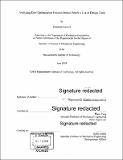| dc.contributor.advisor | Maria Yang. | en_US |
| dc.contributor.author | Gaylord, Elizabeth (Elizabeth H. W.) | en_US |
| dc.contributor.other | Massachusetts Institute of Technology. Department of Mechanical Engineering. | en_US |
| dc.date.accessioned | 2019-01-11T16:05:25Z | |
| dc.date.available | 2019-01-11T16:05:25Z | |
| dc.date.copyright | 2018 | en_US |
| dc.date.issued | 2018 | en_US |
| dc.identifier.uri | http://hdl.handle.net/1721.1/119958 | |
| dc.description | Thesis: S.B., Massachusetts Institute of Technology, Department of Mechanical Engineering, 2018. | en_US |
| dc.description | Cataloged from PDF version of thesis. | en_US |
| dc.description | Includes bibliographical references (pages 21-22). | en_US |
| dc.description.abstract | Design is the first step in creating a product but can be the most challenging. Much design software has been created to meet these needs, but these tools consider only a small part of the design process. This limitation stunts creativity and provides challenges to designers when trying to solve complex problems. Better tools take into account the needs of designers throughout the process of creating, analyzing, and optimizing designs. To provide the best integrated solutions, it is necessary to determine what features of analysis and optimization most help designers explore the solution space and ultimately create better physical designs. Tacit was developed as research tool to create simple designs with analysis and optimization built-in to the software. The most optimized version of Tacit was used as the control in a new study, which utilized two new versions excluding certain optimization features. A comparison between these versions was done to examine how optimization features impacted overall result, solution space exploration, and user experience. The usefulness of these optimization features is highly dependent on the type of problem being solved, and these features do not guarantee the best solution or sufficient exploration of the design space. Results from this experiment allow researchers to identify what is most useful to designers and how better to design tools to help them. | en_US |
| dc.description.statementofresponsibility | by Elizabeth Gaylord. | en_US |
| dc.format.extent | 22 pages | en_US |
| dc.language.iso | eng | en_US |
| dc.publisher | Massachusetts Institute of Technology | en_US |
| dc.rights | MIT theses are protected by copyright. They may be viewed, downloaded, or printed from this source but further reproduction or distribution in any format is prohibited without written permission. | en_US |
| dc.rights.uri | http://dspace.mit.edu/handle/1721.1/7582 | en_US |
| dc.subject | Mechanical Engineering. | en_US |
| dc.title | Analyzing how optimization features impact people's use of design tools | en_US |
| dc.type | Thesis | en_US |
| dc.description.degree | S.B. | en_US |
| dc.contributor.department | Massachusetts Institute of Technology. Department of Mechanical Engineering | |
| dc.identifier.oclc | 1080343157 | en_US |
